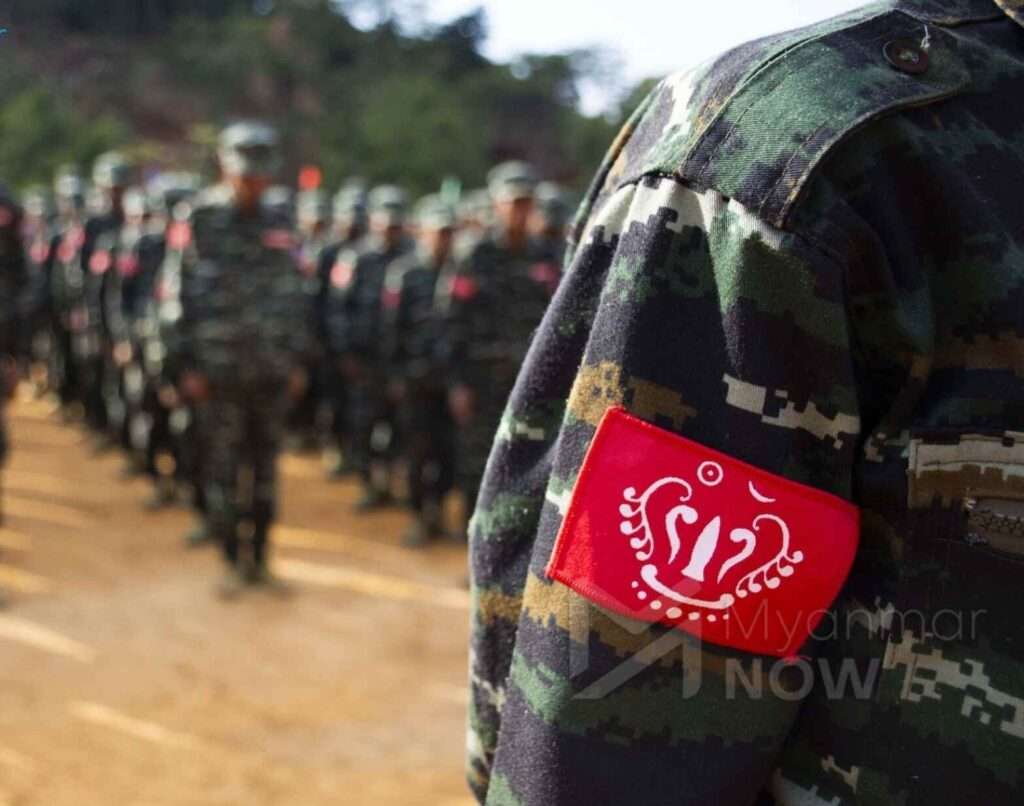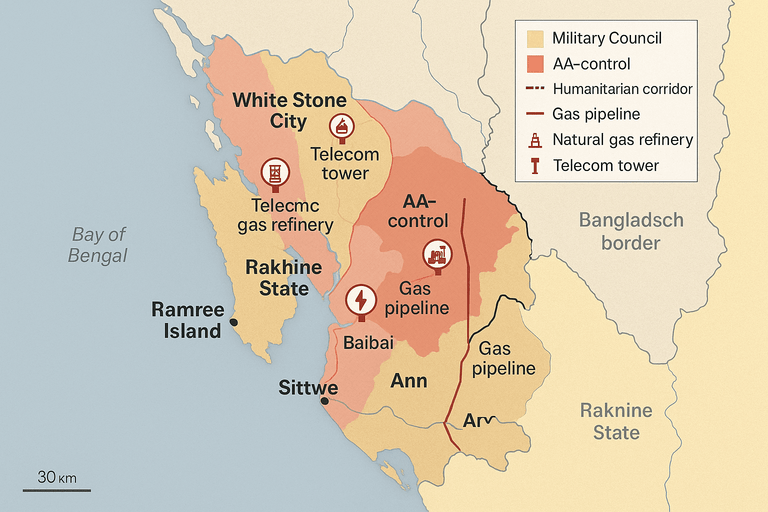The conflict between the Arakan Army (AA) and Myanmar’s Military Council has reached a decisive stage in Rakhine State’s strategically vital White Stone region, an area increasingly seen as the nerve center of China’s economic and strategic interests in Myanmar.
In early June 2025, after a week of intense fighting, the AA successfully seized the MPT Tower Plateau outpost, one of the Myanmar Army’s (MA) key positions located along the Ann–Padan Road on the Yoma Mountain range, which borders Rakhine and Magwe divisions. This marks a significant gain for the AA and signals the possibility of further offensives targeting areas essential to Beijing’s strategic infrastructure.
While a ceasefire had been announced in response to the recent earthquake, the Military Council violated the agreement, prompting retaliatory offensives by the AA. Clashes are now flaring across the country, especially in Rakhine. On June 7, four civilians were killed and ten others including evacuees were wounded when the Military Council bombed AA-controlled regions, striking Stone Village High School and Puzhong Village Primary School with helicopter-launched explosives. Heavy combat continues in and around White Rock Township and the Military Council’s 32nd Battalion, which recently lost several forward bases to AA fighters.
The White Stone Flashpoint: China’s Myanmar Heartland in Crisis
The coastal city of White Stone, nestled in the northern part of Ramree Island, is emerging as a new epicenter of regional contestation. Its strategic value is underscored by the dense concentration of Chinese infrastructure projects, including:
- The China National Petroleum Corporation’s (CNPC) gas pipeline control station
- A natural gas refinery
- A propulsion plant and gas power plant operated by PowerChina
- A second gas facility located in Maladao village, about 10 km southwest of Baibai city
While these facilities remain under the protection of the Military Council, AA’s rapid advances in White Stone suggest that this status quo may soon be overturned. Notably, Chinese-operated drone strikes were reportedly launched from adjacent hills to defend their strategic assets—highlighting how deeply the conflict is beginning to implicate Beijing’s direct interests.
The AA’s current posture signals that the fall of White Stone City could be imminent, delivering a severe blow not only to Naypyidaw but to Beijing’s Belt and Road Initiative (BRI) ambitions in the region. Unlike the MNDAA and TNLA which operate along China’s border and often coordinate with Beijing the AA’s direct threat to Chinese infrastructure poses a more unpredictable challenge to Chinese policymakers.
From Ramree to White Stone: The Strategic Continuum
The AA had previously taken control of Ramree on March 11, 2024, after launching the much-publicized “Operation 1027” in November 2023. Since then, White Stone has become the next logical target. The area’s civilian population has plummeted from 165,352 in the 2014 census to 92,276 in 2024 likely due to displacement caused by persistent fighting and militarization.
Beijing’s Counterpressure: Coercion and Mediation in Play
China is now actively attempting to de-escalate the situation albeit in a manner favoring the Military Council. In late May 2025, Chinese Special Envoy for Asian Affairs, Teng Shiqing, personally mediated talks in Laiza, bringing together AA and Kachin Independence Army (KIA) representatives under Beijing’s ceasefire initiative. This came shortly after MNDAA’s strategic handover of key settlements near Laoshoo to the junta, allegedly under Chinese pressure.
Of particular concern to Beijing is Vanmoor, a port city in southern Kachin state on the Irrawaddy River, offering China its shortest land route to Upper Myanmar. If seized by the KIA, Vanmoor would grant rebels control over Panwa, a region rich in rare earth minerals critical to China’s tech sector. In this broader context, the White Stone offensive is not an isolated rebellion it is a litmus test of China’s ability to shield its overseas strategic investments.
A Twin Challenge to the Junta and Beijing
As of now, the AA has already seized the overland routes from Ramree to White Stone cutting off junta reinforcements via the Mai-Am Highway. Prior counteroffensives, including those launched from naval and air bases around Rakhine, have failed. The White Stone offensive represents a dual strike: one against the military regime and another against China’s regional foothold.
If AA’s leader, known as “Noble Knight”, succeeds in capturing White Stone, it will significantly shift the power dynamics not just within Myanmar, but in the entire Indian Ocean Region (IOR). For Beijing, it would represent the most substantial strategic setback since the 2021 coup. For the AA, it would symbolize the birth of a genuinely indigenous armed resistance capable of resisting both the junta and foreign interference.
During his May 2025 Moscow visit, Chinese President Xi Jinping had reportedly urged Myanmar’s military chief Min Aung Hlaing to ensure the protection of Chinese interests. That assurance is now on the verge of being tested.
Broader Implications: The United States Eyes an Opening
The evolving situation is also drawing new attention from the United States. With the increasing fragility of Chinese operations in Rakhine and the strategic importance of Sittwe Port, Washington is reportedly exploring greater engagement through humanitarian corridors on the Bangladesh–Myanmar border. These routes could offer the U.S. a strategic opening into a China-dominated theater particularly critical if tensions in the Taiwan Strait or South China Sea escalate.
As the White Stone offensive continues to unfold, it serves as a stark reminder that Myanmar’s civil war has far-reaching implications potentially reshaping the regional order across Southeast Asia and the Bay of Bengal.
Conclusion
The Arakan Army, once a key component of the Chinese-backed Three Brotherhood Alliance during “Operation 1027,” has now turned its focus toward strategic targets that threaten core Chinese interests in Rakhine State. This unexpected pivot raises serious questions about the durability of China’s influence over ethnic armed groups in Myanmar. Meanwhile, the United States has begun to quietly increase its engagement in the Indian Ocean Region (IOR), particularly around the Sittwe Port, to counterbalance Beijing’s foothold.
As tensions rise in the Taiwan Strait and South China Sea, the U.S. may seek to deepen its presence in this corridor. Through humanitarian access routes along the Bangladesh–Myanmar border, Washington appears keen to engage with areas now controlled by the AA possibly setting the stage for a broader geopolitical contest over Myanmar’s western seaboard. The White Stone offensive may well become a turning point, not only in Myanmar’s internal conflict, but in the regional power struggle between China and the United States.


